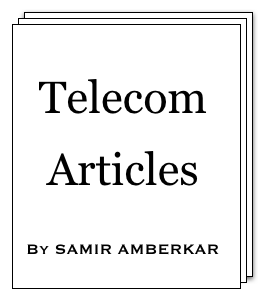LTE - SAE/EPS [Under LTE]
» Service requirements for Evolved Packet System - 22.278, Rel 8 «
» Network architecture - 23.002, Rel 8 «
3G to 4G migration is about using advanced radio access techniques to better (and maximise) the performance of wireless access systems over 3G systems. That is the reason we started LTE discussion with performance requirements and challenges (that LTE radio access will face in meeting those requirements). Then we noted PHY technologies selected for LTE.
Next step would be to look at PHY organisation for LTE (how and why it is flexible and so more efficient ?), but just to maintain similarities with earlier articles on 2G/3G technologies, let us have a quick look at LTE network architecture.
Along side LTE RAN developements, a work was started to enhance (or may even re-invent) core network architecture to suit high performance radio access. Least latency (in both control and data planes) and easier integration with wireline networks were possibly the main targets. The work was called SAE, System Architecture Evolution. SAE work resulted in EPS, Evolved Packet System. As the name suggests, this is meant for packet access. Least latency resulted in fewer nodes and simplified/basic interfaces. Easier integration (helping latency) resulted in "all IP" based interfaces. Below is simplied LTE network architecture:

Note: S8 connect visited S-GW to P-GW of home PLMN.
In new RAN, called E-UTRAN (Evolved-UTRAN), we have eNodeB - handling multiple cells - directly connected to core network. Yes, eNode B is a single unit unlike GSM and UMTS. Core network interfaces and entities are split in control path and data path. MME (Mobility Management Entity) takes care of control functions and user data goes through S-GW (S-GateWay).
Further, S1 and X2 are based on SCTP/IP in control plane and UDP/IP in user plane. You may want to compare this with Iu interfaces which were mostly SS7 based.
In EPS, GSM/GPRS/UMTS core network connect to LTE core network elements over S-interfaces and overall the core network is called EPC, Evolved Packet Core.
WiMAX network architecture is also almost the same (related article). You may also want to have a look at future mobile networks noted in article Tomorrow's mobile wireless to note the similarities.
We would come back on network architecture after discussion on LTE PHY organisation and overall radio access.
References: 3G Evolution: HSPA and LTE by Dahlman, Parkvall, Sköld, and Beming, LTE - From Theory to Practice, Edited by Sesia, Toufik, and Baker, and SAE and the Evolved Packet Core: Driving the Mobile Broadband Revolution by Olsson, Sultana, Rommer, Frid, and Mulligan.
| Copyright © Samir Amberkar 2010-11 | § |
| HSPA Evolution - MIMO « | LTE Index | » LTE - basic PHY structure |


